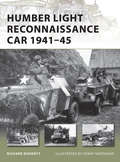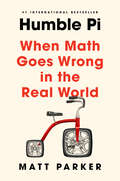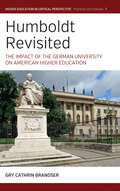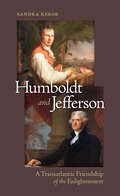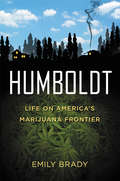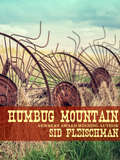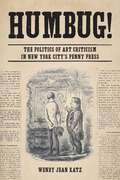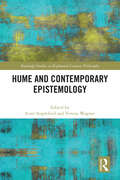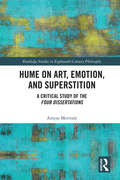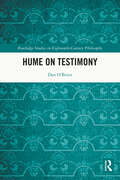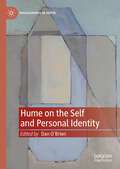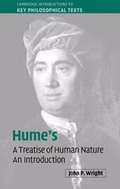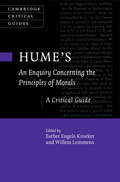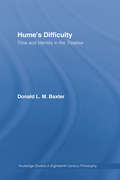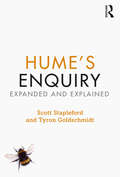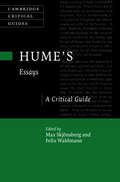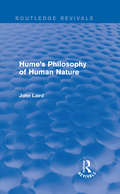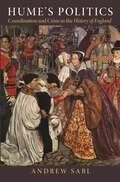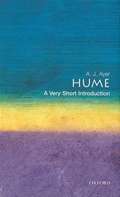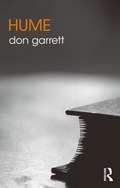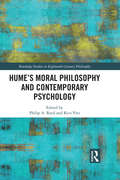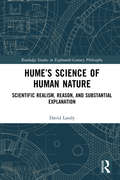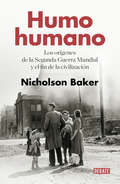- Table View
- List View
Humanökologie (essentials)
by Bernd Herrmann Thomas Potthast Bernhard Glaeseressentials liefern aktuelles Wissen in konzentrierter Form. Die Essenz dessen, worauf es als „State-of-the-Art“ in der gegenwärtigen Fachdiskussion oder in der Praxis ankommt. essentials informieren schnell, unkompliziert und verständlichals Einführung in ein aktuelles Thema aus Ihrem Fachgebietals Einstieg in ein für Sie noch unbekanntes Themenfeldals Einblick, um zum Thema mitreden zu könnenDie Bücher in elektronischer und gedruckter Form bringen das Expertenwissen von Springer-Fachautoren kompakt zur Darstellung. Sie sind besonders für die Nutzung als eBook auf Tablet-PCs, eBook-Readern und Smartphones geeignet. essentials: Wissensbausteine aus den Wirtschafts-, Sozial- und Geisteswissenschaften, aus Technik und Naturwissenschaften sowie aus Medizin, Psychologie und Gesundheitsberufen. Von renommierten Autoren aller Springer-Verlagsmarken.
Humber Light Reconnaissance Car 1941-45
by Henry Morshead Richard DohertyThe iconic vehicle of the British Army's Reconnaissance Corps during World War II, the Humber Light Reconnaissance Car (LRC) saw service in several theatres of war between 1941 and 1945. The Humber LRC gave excellent service to the Reconnaissance Corps with its agility, speed and height proving to be invaluable assets to the units that operated it. Using numerous photographs, and newly commissioned artwork, this book looks at the development of the LRC, its use by the Reconnaissance Corps and its importance to British infantry divisions in the theater in which it served.
Humble Pi: When Math Goes Wrong in the Real World
by Matt ParkerAn international bestsellerThe book-length answer to anyone who ever put their hand up in math class and asked, &“When am I ever going to use this in the real world?&” &“Fun, informative, and relentlessly entertaining, Humble Pi is a charming and very readable guide to some of humanity's all-time greatest miscalculations—that also gives you permission to feel a little better about some of your own mistakes.&” —Ryan North, author of How to Invent Everything Our whole world is built on math, from the code running a website to the equations enabling the design of skyscrapers and bridges. Most of the time this math works quietly behind the scenes . . . until it doesn&’t. All sorts of seemingly innocuous mathematical mistakes can have significant consequences. Math is easy to ignore until a misplaced decimal point upends the stock market, a unit conversion error causes a plane to crash, or someone divides by zero and stalls a battleship in the middle of the ocean. Exploring and explaining a litany of glitches, near misses, and mathematical mishaps involving the internet, big data, elections, street signs, lotteries, the Roman Empire, and an Olympic team, Matt Parker uncovers the bizarre ways math trips us up, and what this reveals about its essential place in our world. Getting it wrong has never been more fun.
Humboldt Revisited: The Impact of the German University on American Higher Education (Higher Education in Critical Perspective: Practices and Policies #7)
by Gry Cathrin BrandserHumboldt Revisited offers a fresh perspective on the contemporary discourse surrounding reform of European universities. Arguing that contemporary reform derives its basis from pre-constructed truths about the so-called ‘Humboldt-university,’ this monograph traces the historical descent of these truths to the American reception of Humboldt's ideas from the mid-19th century up until the 1960s. Drawing from a rich selection of historical sources, this volume offers an alternative to conventional explanations of the forces behind the ongoing reform of European universities. It also challenges the conventional historical narrative on the Humboldt University, providing new insight into the American reception of the German ideas.
Humboldt and Jefferson: A Transatlantic Friendship of the Enlightenment (CARAF Books: Caribbean and African Literature translated from the French)
by Sandra RebokHumboldt and Jefferson explores the relationship between two fascinating personalities: the Prussian explorer, scientist, and geographer Alexander von Humboldt (1769–1859) and the American statesman, architect, and naturalist Thomas Jefferson (1743–1826). In the wake of his famous expedition through the Spanish colonies in the spring of 1804, Humboldt visited the United States, where he met several times with then-president Jefferson. A warm and fruitful friendship resulted, and the two men corresponded a good deal over the years, speculating together on topics of mutual interest, including natural history, geography, and the formation of an international scientific network. Living in revolutionary societies, both were deeply concerned with the human condition, and each vested hope in the new American nation as a possible answer to many of the deficiencies characterizing European societies at the time.The intellectual exchange between the two over the next twenty-one years touched on the pivotal events of those times, such as the independence movement in Latin America and the applicability of the democratic model to that region, the relationship between America and Europe, and the latest developments in scientific research and various technological projects. Humboldt and Jefferson explores the world in which these two Enlightenment figures lived and the ways their lives on opposite sides of the Atlantic defined their respective convictions.
Humboldt: Life on America's Marijuana Frontier
by Emily BradyIn the vein of Susan Orlean's The Orchid Thief and Deborah Feldman's Unorthodox, journalist Emily Brady journeys into a secretive subculture--one that marijuana built. Humboldt: Life on America's Marijuana FrontierSay the words "Humboldt County" to a stranger and you might receive a knowing grin. The name is infamous, and yet the place, and its inhabitants, have been nearly impenetrable. Until now.Humboldt is a narrative exploration of an insular community in Northern California, which for nearly 40 years has existed primarily on the cultivation and sale of marijuana. It's a place where business is done with thick wads of cash and savings are buried in the backyard. In Humboldt County, marijuana supports everything from fire departments to schools, but it comes with a heavy price. As legalization looms, the community stands at a crossroads and its inhabitants are deeply divided on the issue--some want to claim their rightful heritage as master growers and have their livelihood legitimized, others want to continue reaping the inflated profits of the black market. Emily Brady spent a year living with the highly secretive residents of Humboldt County, and her cast of eccentric, intimately drawn characters take us into a fascinating, alternate universe. It's the story of a small town that became dependent on a forbidden plant, and of how everything is changing as marijuana goes mainstream.
Humbug Mountain
by Sid FleischmanWelcome to Humbug Mountain! Little did Wiley, the son of a traveling newspaperman, imagine that the search for his grandfather would lead him into the hands of those nasty villains of the West--Shagnasty John and the Fool Killer. Using their newspaper, The Humbug Mountain Hoorah, Wiley and his sister and mother go about outwitting the outlaws in their scheme to ambush Grandfather's new boat and its cargo of gold. Winner of the Boston Globe-Horn Book Award, from Newbery Award-winning author Sid Flesichman.
Humbug!: The Politics of Art Criticism in New York City's Penny Press
by Wendy Jean KatzApproximately 300 daily and weekly newspapers flourished in New York before the Civil War. A majority of these newspapers, even those that proclaimed independence of party, were motivated by political conviction and often local conflicts. Their editors and writers jockeyed for government office and influence. Political infighting and their related maneuvers dominated the popular press, and these political and economic agendas led in turn to exploitation of art and art exhibitions. Humbug traces the relationships, class animosities, gender biases, and racial projections that drove the terms of art criticism, from the emergence of the penny press to the Civil War.The inexpensive “penny” papers that appeared in the 1830s relied on advertising to survive. Sensational stories, satire, and breaking news were the key to selling papers on the streets. Coverage of local politicians, markets, crime, and personalities, including artists and art exhibitions, became the penny papers’ lifeblood. These cheap papers, though unquestionably part of the period’s expanding capitalist economy, offered socialists, working-class men, bohemians, and utopianists a forum in which they could propose new models for American art and society and tear down existing ones.Arguing that the politics of the antebellum press affected the meaning of American art in ways that have gone unrecognized, Humbug covers the changing politics and rhetoric of this criticism. Author Wendy Katz demonstrates how the penny press’s drive for a more egalitarian society affected the taste and values that shaped art, and how the politics of their art criticism changed under pressure from nativists, abolitionists, and expansionists. Chapters explore James Gordon Bennett’s New York Herald and its attack on aristocratic monopolies on art; the penny press’s attack on the American Art-Union, an influential corporation whose Board purchased artworks from living artists, exhibited them in a free gallery, and then distributed them in an annual five-dollar lottery; exposés of the fraudulent trade in Old Masters works; and the efforts of socialists, freethinkers, and bohemians to reject the authority of the past.
Hume and Contemporary Epistemology (Routledge Studies in Eighteenth-Century Philosophy)
by Scott StaplefordThis is the first edited collection dedicated to demonstrating Hume’s relevance to contemporary debates in epistemology. It features original essays by Hume scholars and epistemologists that address a wide range of important questions, including the following: What does a Humean conception of knowledge look like? How do Hume’s understanding of belief and suspension of judgement bear on current debates about doxastic attitudes? Is there a Humean way of uniting reasons in the epistemic and practical domains? What is the proper role of reason at the foundations of ethics and epistemology from a Humean point of view? What contribution might an examination of Humean scepticism make to understanding of current sceptical hypotheses? Is Hume a hinge epistemologist? Does naturalized epistemology trace back to Hume? Does Hume have an ethics of belief? What can Hume contribute to virtue and vice epistemology? Some chapters try to bring historically accurate interpretations of Hume’s ideas into contact with current issues, while others will take ideas merely suggested by Hume and demonstrate their philosophical usefulness. Together, they demonstrate Hume’s enduring relevance for debates about knowledge, belief, inquiry and suspension, reasons, modal knowledge, scepticism, hinge epistemology, naturalized epistemology, the ethics of belief and moral epistemology, virtue and vice epistemology, and the epistemology of testimony.Hume and Contemporary Epistemology will be of interest to scholars and advanced students working on Hume, epistemology, and the history of philosophy.
Hume on Art, Emotion, and Superstition: A Critical Study of the Four Dissertations (Routledge Studies in Eighteenth-Century Philosophy)
by Amyas MerivaleThis book offers the first comprehensive critical study of David Hume’s Four Dissertations of 1757, containing the Natural History of Religion, the Dissertation on the Passions, and the two essays Of Tragedy and Of the Standard of Taste. The author defends two important claims. The first is that these four works were not published together merely for convenience, but that they form a tightly integrated set, unified by the subject matter of the passions. The second is that the theory of the passions they jointly present is significantly different—indeed, significantly improved—from that of the earlier Treatise. Most strikingly, it is anti-egoist and anti-hedonist about motivation, where the Treatise had espoused a Lockean hedonism and egoism. It is also more cognitivist in its analysis of the passions themselves, and demonstrates a greater awareness of the limits of sympathy and of the varieties of human taste. This book is an important contribution to the scholarly literature on Hume’s work on the passions, art, and superstitious belief.
Hume on Testimony (Routledge Studies in Eighteenth-Century Philosophy)
by Dan O'BrienThis book is the first devoted to Hume’s conception of testimony. Hume is usually taken to be a reductionist with respect to testimony, with trust in others dependent on the evidence possessed by individuals concerning the reliability of texts or speakers. This account is taken from Hume’s essay on miracles in An Enquiry concerning Human Understanding. O’Brien, though, looks wider than the miracles essay, turning to what Hume says about testimony in the Treatise, the moral Enquiry, the History of England and his Essays. There are social aspects of testimonial exchanges that cannot be explained purely in terms of the assessment of the reliability of testifiers. Hume’s conception of testimony is integrated with his account of how history informs our knowledge of human nature, the relation between sympathy and belief and between pride and the conception we have of our selves, the role played by social factors in the judgment of intellectual virtue, and the importance Hume places on epistemic responsibility and the moral and personal dimensions of testimonial trust. It is not possible to focus on testimony without allowing other aspects of our nature into the frame and therefore turning also to consider sympathy, wisdom, history, morality, virtue, aesthetic judgment, the self and character. O’Brien argues that Hume’s reliance on the social goes deep and that he should therefore be seen as an anti-reductionist with respect to testimony. Hume on Testimony will be of interest to researchers and advanced students working on Hume and on early modern and contemporary approaches to the epistemology of testimony.
Hume on the Self and Personal Identity (Philosophers in Depth)
by Dan O’BrienThis book brings together a team of international scholars to attempt to understand David Hume’s conception of the self. The standard interpretation is that he holds a no-self view: we are just bundles of conscious experiences, thoughts and emotions. There is nothing deeper to us, no core, no essence, no soul. In the Appendix to A Treatise of Human Nature, though, Hume admits to being dissatisfied with such an account and Part One of this book explores why this might be so. Part Two turns to Books 2 and 3 of the Treatise, where Hume moves away from the ‘fiction’ of a simple self, to the complex idea we have of our flesh and blood selves, those with emotional lives, practical goals, and social relations with others. In Part Three connections are traced between Hume and Madhyamaka Buddhism, Husserl and the phenomenological tradition, and contemporary cognitive science.
Hume's 'A Treatise of Human Nature'
by John P. WrightDavid Hume's A Treatise of Human Nature (1739-40) presents the most important account of skepticism in the history of modern philosophy. In this lucid and thorough introduction to the work, John P. Wright examines the development of Hume's ideas in the Treatise, their relation to eighteenth-century theories of the imagination and passions, and the reception they received when Hume published the Treatise. He explains Hume's arguments concerning the inability of reason to establish the basic beliefs which underlie science and morals, as well as his arguments showing why we are nevertheless psychologically compelled to accept such beliefs. The book will be a valuable guide for those seeking to understand the nature of modern skepticism and its connection with the founding of the human sciences during the Enlightenment.
Hume's An Enquiry Concerning the Principles of Morals: A Critical Guide (Cambridge Critical Guides)
by Esther Engels Kroeker Willem LemmensHume considered his Enquiry Concerning the Principles of Morals to be one of his best works. In it he offers his most elegant and approachable account of the origins and scope of morality. With the hope of reaching a broad audience, he argues that morality is neither rigid nor austere, but is rather a product of sentiments that all human beings share, and which they are naturally inclined to recognize and act upon. In this Critical Guide, a team of distinguished scholars discuss each section of the Enquiry, its place in Hume's philosophy as a whole, and its historical context; their topics include the nature of morals, talents and moral virtues, benevolence, sympathy, and the sources of moral disagreement. The volume will be valuable for scholars and advanced students working on Hume.
Hume's Difficulty: Time and Identity in the Treatise (Routledge Studies in Eighteenth-Century Philosophy #Vol. 7)
by Donald L.M. BaxterIn this volume--the first, focused study of Hume on time and identity--Baxter focuses on Hume’s treatment of the concept of numerical identity, which is central to Hume's famous discussions of the external world and personal identity. Hume raises a long unappreciated, and still unresolved, difficulty with the concept of identity: how to represent something as "a medium betwixt unity and number." Superficial resemblance to Frege’s famous puzzle has kept the difficulty in the shadows. Hume’s way of addressing it makes sense only in the context of his unorthodox theory of time. Baxter shows the defensibility of that theory against past dismissive interpretations, especially of Hume’s stance on infinite divisibility. Later the author shows how the difficulty underlies Hume’s later worries about his theory of personal identity, in a new reading motivated by Hume’s important appeals to consciousness. Baxter casts Hume throughout as an acute metaphysician, and reconciles this side of Hume with his overarching Pyrrhonian skepticism.
Hume's Enquiry: Expanded and Explained
by David Hume Tyron Goldschmidt Scott StaplefordHume’s Enquiry: Expanded and Explained includes the entire classical text of David Hume’s An Enquiry Concerning Human Understanding in bold font, a running commentary blended seamlessly into the text in regular font, and analytic summaries of each section. The commentary is like a professor on hand to guide the reader through every line of the daunting prose and every move in the intricate argumentation. The unique design helps students learn how to read and engage with one of modern philosophy’s most important and exciting classics. Key Features: Includes the entire original text. Provides helpful summaries of each paragraph. Offers commentary on every line of text. Removes the gap between commentary and text.
Hume's Essays: A Critical Guide (Cambridge Critical Guides)
by Max Skjönsberg Felix WaldmannDavid Hume's Essays, which were written and published at various junctures between 1741 and his death in 1776, offer his most accessible and often most profound statements on a range of subjects including politics, philosophy, aesthetics, and political economy. In Hume's lifetime, the readable and wide-ranging Essays acquired considerable fame throughout Europe and North America, influencing the writings of such diverse figures as James Madison and William Paley, yet they have not been given the same scholarly attention as his more famous philosophical works. This Critical Guide provides a series of in-depth studies of the Essays, as well as an account of the state of scholarship on the work. Thirteen chapters examine the Essays from historical, political and philosophical perspectives, with the aim of restoring the work to its rightful place among Hume's works and in intellectual history more broadly.
Hume's Philosophy of Human Nature (Routledge Revivals)
by John LairdThe essence of Hume’s eighteenth-century philosophy was that all the sciences were ‘dependent on the science of man’, and that the foundations of any such science need to rest on experience and observation. This title, first published in 1932, examines in detail how Hume interpreted ‘the science of man’ and how he applied his experimental methodology to humankind’s understanding, passions, social duties, economic activities, religious beliefs and secular history throughout his career. Particular attention is paid to the English, French and Latin sources that shaped Hume’s theories. This is a full and fascinating title, of particular relevance to students with an interest in the philosophy of Hume specifically, as well as the philosophy of human nature and the methodologies applied to its study more generally.
Hume's Politics: Coordination and Crisis in the History of England
by Andrew SablHume's Politics provides a comprehensive examination of David Hume's political theory, and is the first book to focus on Hume's monumental History of England as the key to his distinctly political ideas. Andrew Sabl argues that conventions of authority are the main building blocks of Humean politics, and explores how the History addresses political change and disequilibrium through a dynamic treatment of coordination problems. Dynamic coordination, as employed in Hume's work, explains how conventions of political authority arise, change, adapt to new social and economic conditions, improve or decay, and die. Sabl shows how Humean constitutional conservatism need not hinder--and may in fact facilitate--change and improvement in economic, social, and cultural life. He also identifies how Humean liberalism can offer a systematic alternative to neo-Kantian approaches to politics and liberal theory. At once scholarly and accessibly written, Hume's Politics builds bridges between political theory and political science. It treats issues of concern to both fields, including the prehistory of political coordination, the obstacles that must be overcome in order for citizens to see themselves as sharing common political interests, the close and counterintuitive relationship between governmental authority and civic allegiance, the strategic ethics of political crisis and constitutional change, and the ways in which the biases and injustices endemic to executive power can be corrected by legislative contestation and debate.
Hume: A Very Short Introduction
by Alfred Jules AyerBiography of Hume and a cogent discussion of his philosophy.
Hume: Critical Essays On Locke, Berkeley, And Hume (The Routledge Philosophers)
by Don GarrettBeginning with an overview of Hume's life and work, Don Garrett introduces in clear and accessible style the central aspects of Hume's thought. These include Hume's lifelong exploration of the human mind; his theories of inductive inference and causation; skepticism and personal identity; moral and political philosophy; aesthetics; and philosophy of religion. The final chapter considers the influence and legacy of Hume's thought today. Throughout, Garrett draws on and explains many of Hume's central works, including his Treatise of Human Nature, Enquiries Concerning Human Understanding, and Dialogues Concerning Natural Religion. Hume is essential reading not only for students of philosophy, but anyone in the humanities and social sciences and beyond seeking an introduction to Hume's thought.
Hume’s Moral Philosophy and Contemporary Psychology (Routledge Studies in Eighteenth-Century Philosophy)
by Rico Vitz Philip A. ReedRecent work at the intersection of moral philosophy and the philosophy of psychology has dealt mostly with Aristotelian virtue ethics. The dearth of scholarship that engages with Hume’s moral philosophy, however, is both noticeable and peculiar. Hume's Moral Philosophy and Contemporary Psychology demonstrates how Hume’s moral philosophy comports with recent work from the empirical sciences and moral psychology. It shows how contemporary work in virtue ethics has much stronger similarities to the metaphysically thin conception of human nature that Hume developed, rather than the metaphysically thick conception of human nature that Aristotle espoused. It also reveals how contemporary work in moral motivation and moral epistemology has strong affinities with themes in Hume’s sympathetic sentimentalism.
Hume’s Science of Human Nature: Scientific Realism, Reason, and Substantial Explanation (Routledge Studies in Eighteenth-Century Philosophy)
by David LandyHume’s Science of Human Nature is an investigation of the philosophical commitments underlying Hume's methodology in pursuing what he calls ‘the science of human nature’. It argues that Hume understands scientific explanation as aiming at explaining the inductively-established universal regularities discovered in experience via an appeal to the nature of the substance underlying manifest phenomena. For years, scholars have taken Hume to employ a deliberately shallow and demonstrably untenable notion of scientific explanation. By contrast, Hume’s Science of Human Nature sets out to update our understanding of Hume’s methodology by using a more sophisticated picture of science as a model.
Humo humano: Los orígenes de la Segunda Guerra Mundial y el fin de la civilización
by Nicholson BakerUn libro inolvidable que tendrá un profundo efecto sobre nuestra visión de los acontecimientos históricos que culminaron en la Segunda Guerra Mundial y que contiene un sentido lamento por la irreparable pérdida que la humanidad se ha causado a sí misma. No es fácil aplicar una luz distinta a acontecimientos muy conocidos, pero eso es lo que logra Nicholson Baker en esta extraordinaria historia de los orígenes de la Segunda Guerra Mundial. A partir de fragmentos extraídos de periódicos y revistas de la época, discursos radiofónicos, panfletos, diarios y libros de memorias, entre otras fuentes, ordenados cronológicamente, Baker crea un mosaico de momentos decisivos, de barbarie, sufrimiento y compasión, de iluminadores destellos sobre escenas cotidianas e históricas. Una obra coral que, setenta años después, nos deja oír las voces de los líderes políticos y sus opositores, escritores, periodistas, militares y pacifistas, testimonios que ilustran de manera conmovedora el imparable y horrible avance hacia la guerra global y el holocausto. Elogiado por la crítica y los lectores por su capacidad de observación y su límpida prosa, Baker ha creado una narración que se desarrolla elegante, trágica y convincentemente. Reseñas:«Este libro absolutamente extraordinario -imposible de abandonar, imposible de olvidar- podría convertirse en el argumento más convincente en favor de la paz jamás construido. Este inventario meticulosamente seleccionado por Nicholson Baker muestra con asombroso y fascinante detalle el imparable descenso de la humanidad hacia la locura de la guerra.»Simon Winchester «Lentamente, a medida que lees, como consecuencia de la variedad en el tono y de la naturaleza trágica o terrible de la cita, así como de lo certero de su elección, Humo humano se vuelve apasionante y fascinante. Sin embargo, las cuestiones que Baker quiere plantear y el descarnado estilo que emplea para hacerlo, hacen de su libro una contribución seria y convencida al debate sobre el pacifismo. Ha creado un apasionante y elocuente ataque a la idea de que la elección deliberada de objetivos civiles pueda estar nunca justificada.»Colm Tóibín, The New York Times «Baker se vuelve especialmente interesante y provocativo al intentar demostrar que los terribles horrores del nazismo reafirman la postura pacifista.»Piers Brendon, The Guardian «Un libro que me ha encantado. Fascinante, sobrecogedor, instructivo, apasionante.»A.C. Grayling, The Times «Un fascinante y audaz experimento histórico literario, hay que aplaudir la originalidad y sutileza de su enfoque. Humo humano merece una entusiasta acogida.»Geoff Dyer, The Financial Times «Un texto coral en el que son los protagonistas quienes toman la palabra. [...]El resultado es perturbador, como si, de pronto, hubieran sido convocados a escena todos los silencios, todos los equívocos imprescindibles para que la historia de la II Guerra Mundial se pueda seguir contando como hasta ahora.»José María Ridao, El País

